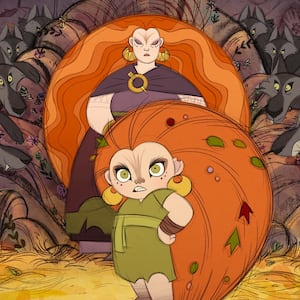Given that Sunday’s Oscars ended on an Anthony Hopkins headshot and a genuinely shocking Chadwick Boseman snub, I won’t say that Wolfwalkers losing out on Best Animated Feature was the most egregious oversight of the evening—but it’s certainly up there.
Going into Sunday night, Soul’s win already felt inevitable—so unavoidable, in fact, that pre-emptive pieces explained why such a decision would be disappointing. Soul, like most Pixar releases, is a gorgeous visual work, but its premise, in some ways, outdoes the execution. It’s the first film from the studio to feature a Black lead, but in a continuation of a pernicious trope, Jamie Foxx’s music teacher protagonist Joe Gardner spends most of the film as a dead, amorphous blob—that is, until he takes over the body of a cat. Soul also feels, in some ways, derivative of Docter’s earlier work, which uses corporate structures to make sense of the intangible and metaphysical aspects of human existence. (See: Monsters, Inc. and Inside Out.)
But it’s not just the Oscars’ notorious default setting of awarding Pixar almost every chance it gets that makes Wolfwalkers’ loss to Soul so upsetting. It’s the fact that Wolfwalkers itself is a masterpiece—an imaginative and heart-rending story made all the more captivating by Irish animation studio Cartoon Saloon’s meticulous and full-hearted embrace of its medium.
Wolfwalkers, the third installment of what co-directors Tomm Moore and Ross Stewart have characterized as a folkloric trilogy, takes place in 17th-century Ireland and tells the story of a young English girl named Robyn Goodfellowe (Honor Kneafsey)—whose father, Bill (Sean Bean), is working to conquer the forest by driving out a pack of wolves. (As Stewart pointed out during a recent interview with The Daily Beast, Oliver Cromwell, who led the invasion of Ireland, saw wolves as “a symbol of how wild and untamed this colony of the British Empire was.”)
Robyn chafes at life in the town of Kilkenny, where she’s constantly being forced into performing domestic work in a bonnet and skirt. She’d much rather be out tramping through the woods with her father, who insists it’s too dangerous.
Soon enough, Robyn makes a break for the wilderness with her falcon familiar, Merlyn. But when faced with a wolf, Robyn shoots her feathered friend in a panic. A wild girl named Mebh emerges from the forest and takes the falcon with her; Robyn follows only to find her bird miraculously healed.
Mebh is a wolfwalker—a member of a mysterious tribe of magical beings who walk the Earth as human by day but transform to wolves at night. And thanks to an accidental bite, Robyn soon finds herself gifted with the same ability—although early on, as she scrambles to escape the city and her father, unaware that his daughter is now one of the wolves he seeks to destroy, Robyn’s new identity feels more like a curse.
With every frame, Wolfwalkers becomes more enchanting. The greenery of the forest is a glimmering watercolor wonder—as enchanting as a lovingly illustrated children’s book, and alluring enough to compete with the mysterious allure of any real-life forest. 17th-century woodcuts inspire the walled town’s animation, imparting a militant stiffness. (“Every time we were drawing something associated with the town, we’d have these keywords, like it had to be like a ‘cage,’ it had to show ‘control,’ it had to be ‘rigid,’” Stewart said.) Characters, like the wilderness, appear less constrained; sketch lines remind viewers of the detailed work that went into every frame. Mebh, in particular, is an astounding creation whose face never stops shifting between cherubic and wolfish, her little body a constant engine of motion beneath her leaf-tangled swoosh of hair.
But on top of its craftsmanship, Wolfwalkers’ story, with its carefully braided themes and folklore, merits recognition in its own right.
In meeting Mebh and becoming like her, Robyn begins to contemplate possibilities she never knew existed. As she and Mebh treat the woods as their personal playground by moonlight, the hand-drawn foliage of the forest glows with ethereal magic all its own. The ruffling leaves and twisting vines offering a stark visual contrast to Robyn’s sterile, desaturated existence within her walled city. And so, the wilderness becomes a mysterious and ethereal backdrop for the film’s coming-of-age tale.
The more time she spends with Mebh, the more Robyn realizes that the strict boundaries and rigid hierarchies she’s known all her life are, like the walls designed to separate her from the untamed forest, man-made. Perhaps, then, they are not obligatory either.
At every turn, Wolfwalkers embraces the individual over the institution and examines powerful entities like church and state as suppressors of individuality and identity. Robyn and Mebh’s friendship offers all the plot beats that, for a male and female character, would imply a romantic connection—albeit an innocent one, given that both seem to be pre-teens. The pair’s relationship is one of exploration and discovery, and Wolfwalkers’ co-directors do not shy away from what their bond could mean.
If anything, Moore and Stewart’s film seems to encourage and reward a queer reading. Wolfwalkers’ most impactful scene, in which Mebh first shows Robyn how to run with their lupine kin, comes alive in a blue and pink twilight haze; the two playfully jostle each other and tumble down a hill together in a tangle of limbs. In the end, they bathe themselves in a sudden rainstorm, as though nature itself has baptized Robyn anew. All the while, Aurora’s “Running with the Wolves” soars overhead—a passionate, unrestrained ode to freedom and nature.
It’s that sense of possibility and wonder that sets Wolfwalkers apart from the pack. From its bold visual style to its refusal to assure us that Robyn and Mebh are “just friends!”, the film sets itself apart in all the right ways. Rather than tell its viewers how to see, Wolfwalkers invites each of us to explore our own perspectives with more openness and depth—to find the wolf living inside each of us, and to run with it instead of from it. Even if it lost out on the Oscar, we could all stand to sit with that message for a little while.


